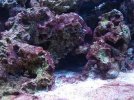jrf1175
Member
I know there are 100's of threads on all the forums about cyano. I have read almost all of them and tried just about everything!
A bit of system info:
Running phosban for a month now with RowaPhos.
2x 6045 for circulation + return
Skimmer Skimming at a good rate
Runnign RO/DI water
There is natural light in the room, but the blinds remain closed most of the day.
I have treated (before livestock we added) with Red Slime Remover with no positive results
I have siphoned as much cyano as I can during numerous water changes from rocks and sand. However, you can never get it all...
Water parameters are all good with very minimal nitrates and phosphates.
Only have 2 Oc. Clowns and 4 Green Chromis. Feeding ORA pellets and cyclop-eeze wafers twice a day and definitely not in excess. I am currently soaking some feed in some RO/DI water and will run some tests on the water to see how much the feed could be contributing.
The problem is my cyano is still growing of out of control! Her are a few photos 3 days after a big water change and removal of cyano via siphon.
I am really at a loss for other possible solutions????
So I have a few other questions...
Should I continue to remove it during water changes? I know this is know to help and will remove the nutrients in the bacteria....BUT - if I let is grow should it not max out and being to die off once it has consumed all the available nutrients? Removing it hasn't worked yet and so many water changes are costing me a fortune in salt.
I'm currently using Reef Crystals salt mix...any one have experience with this? I am thinking of changing to Tropic Marine to see if that helps.
Regarding lighting. I bought my unit used and haven't replaced the MH lights. Could this be a major contributor if they are on the end of there "lifecycle" If so, what is a good brand of 250W MHs. I think I am running MegaChrome now, but i know they are $$!!!!
Any, and I mean any help here would be greatly appreciated! I am beginning to lose my mind and confidence here and not really enjoying myself with this right now...it just seems I can't win!
As soon as I run my Tests on the feed rinse water I will post.
Cheers
J
A bit of system info:
Running phosban for a month now with RowaPhos.
2x 6045 for circulation + return
Skimmer Skimming at a good rate
Runnign RO/DI water
There is natural light in the room, but the blinds remain closed most of the day.
I have treated (before livestock we added) with Red Slime Remover with no positive results
I have siphoned as much cyano as I can during numerous water changes from rocks and sand. However, you can never get it all...
Water parameters are all good with very minimal nitrates and phosphates.
Only have 2 Oc. Clowns and 4 Green Chromis. Feeding ORA pellets and cyclop-eeze wafers twice a day and definitely not in excess. I am currently soaking some feed in some RO/DI water and will run some tests on the water to see how much the feed could be contributing.
The problem is my cyano is still growing of out of control! Her are a few photos 3 days after a big water change and removal of cyano via siphon.
I am really at a loss for other possible solutions????
So I have a few other questions...
Should I continue to remove it during water changes? I know this is know to help and will remove the nutrients in the bacteria....BUT - if I let is grow should it not max out and being to die off once it has consumed all the available nutrients? Removing it hasn't worked yet and so many water changes are costing me a fortune in salt.
I'm currently using Reef Crystals salt mix...any one have experience with this? I am thinking of changing to Tropic Marine to see if that helps.
Regarding lighting. I bought my unit used and haven't replaced the MH lights. Could this be a major contributor if they are on the end of there "lifecycle" If so, what is a good brand of 250W MHs. I think I am running MegaChrome now, but i know they are $$!!!!
Any, and I mean any help here would be greatly appreciated! I am beginning to lose my mind and confidence here and not really enjoying myself with this right now...it just seems I can't win!
As soon as I run my Tests on the feed rinse water I will post.
Cheers
J

